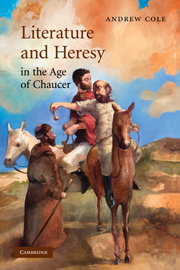Book contents
- Frontmatter
- Contents
- Preface
- Acknowledgments
- List of abbreviations
- PART I THE INVENTION OF HERESY
- PART II THE LATE FOURTEENTH CENTURY: CANONIZING WYCLIFFISM
- 2 The invention of “lollardy”: William Langland
- 3 The reinvention of “lollardy”: William Langland and his contemporaries
- Intermezzo: Wycliffism is not “lollardy”
- 4 Geoffrey Chaucer's Wycliffite text
- PART III THE EARLY FIFTEENTH CENTURY: HERETICS AND EUCHARISTS
- PART IV FEELING WYCLIFFITE
- PART V EPILOGUE
- Notes
- Bibliography
- Index of manuscripts cited
- General index
- CAMBRIDGE STUDIES IN MEDIEVAL LITERATURE
2 - The invention of “lollardy”: William Langland
Published online by Cambridge University Press: 22 September 2009
- Frontmatter
- Contents
- Preface
- Acknowledgments
- List of abbreviations
- PART I THE INVENTION OF HERESY
- PART II THE LATE FOURTEENTH CENTURY: CANONIZING WYCLIFFISM
- 2 The invention of “lollardy”: William Langland
- 3 The reinvention of “lollardy”: William Langland and his contemporaries
- Intermezzo: Wycliffism is not “lollardy”
- 4 Geoffrey Chaucer's Wycliffite text
- PART III THE EARLY FIFTEENTH CENTURY: HERETICS AND EUCHARISTS
- PART IV FEELING WYCLIFFITE
- PART V EPILOGUE
- Notes
- Bibliography
- Index of manuscripts cited
- General index
- CAMBRIDGE STUDIES IN MEDIEVAL LITERATURE
Summary
You have spoken enough of Wickliffe, and his Disciples; what were those Lollards you mentioned?
Simon BirckbeckLollard, Lollards, Lollardy: these are the people, these are the things, these are the words, that since the medieval period have colored the historical accounts of John Wyclif and his followers, those so-called “lollards” who adhere to a radical form of religion called “lollardy.” The question is, What are “lollards”? What is “lollardy”? No words are used more frequently by scholars of late medieval English literary and religious culture whose sense, history, and usage are so murky. It is time to be clear about “lollardy” and its specific connection to the partisan writing and rewriting of the history of Wycliffite heresy. I have already discussed some aspects of this historical writing in the previous chapter where I looked at the diffusion of anti-Wycliffite rhetoric among orthodox sermons, parliamentary statutes, chronicles, poems, trial accounts, and ecclesiastical publications: in 1382, Archbishop William Courtenay saw to the successful condemnation of Wycliffite teachings at the Blackfriars Council in London, and after the Council, he pursued a massive publicity campaign that all but guaranteed the posting on every church door within the see of the Council's siren condemnation of Wycliffite heresy, which was said to spread heretical depravities throughout all of England by means of illegal preaching, preachers who “usurp to themselves the office of preaching”.
- Type
- Chapter
- Information
- Literature and Heresy in the Age of Chaucer , pp. 25 - 45Publisher: Cambridge University PressPrint publication year: 2008



